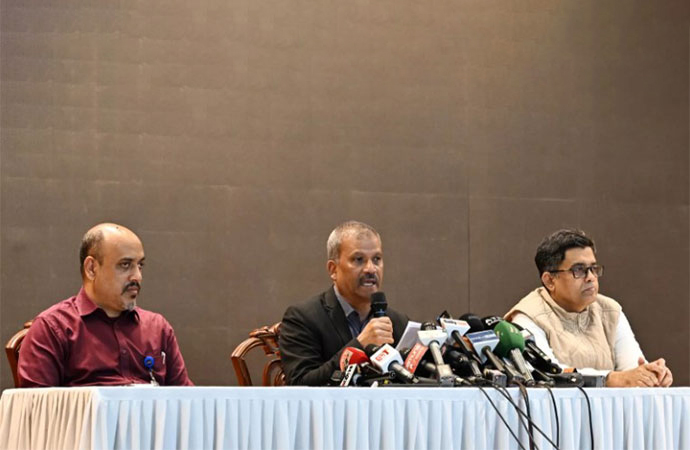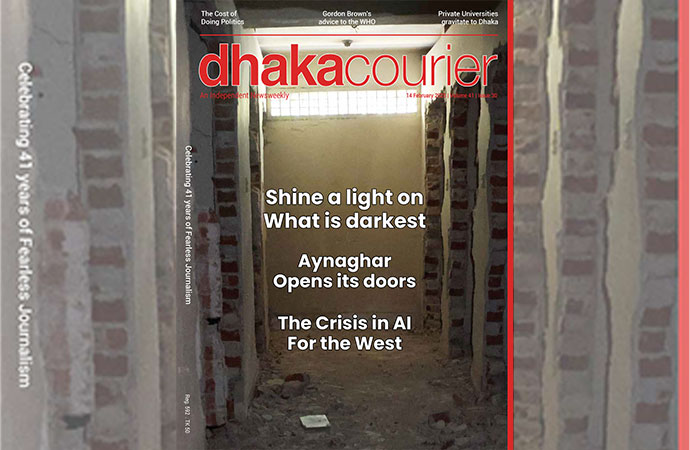Reportage

Photo: Anirban Sengupta
Time was when pollution, even in its most pervasive (and deadliest, that permeates air) form, used to be regarded here in Bangladesh as something of a 'First World problem'. With the harm done by its unchecked manifestation so poorly understood, Bangladeshis nurtured a decidedly unhealthy, yet blissfully ignorant view of the subject, save some environmentalists and assorted 'jholas'. When people wearing facemasks to guard against the toxic brew that passes for air in our urban centres first started appearing, they were looked at with a combination of scorn and bewilderment.
That callous attitude, coupled with an almost deceptively robust economy that last grew at a rate below 5 percent in 2003 going by World Bank data, provided fertile ground for the problem to fester and grow exponentially. So much so that today, armed with a better understanding of the issue, we are quickly catching on that we've bred an absolute killer that slots in so seamlessly among us, that it's hard to think of another society on our dear blue planet, where pollution finds such full and unfettered expression.
A number of inconvenient truths (and the documentary by Al Gore of a similar name was never a million miles away, since the issue of climate change is intrinsically tied to pollution of the atmosphere) have emerged in recent times to bear this out, and to its credit, the media in Bangladesh has accorded them due importance. It can be difficult to ignore when credible sources are telling you, as the 2018 World Air Quality Report released earlier this month did, that Bangladesh has the most polluted air in the world and Dhaka is the second most polluted capital city.
"At a country level, weighted by population, Bangladesh emerges as the most polluted country," stated the report by advocacy group Greenpeace and AirVisual, which monitors air quality across the globe. It was prepared on the basis of last year's data collected from public monitoring sources, and focuses on PM2.5 as a representative measure of air pollution.
PM2.5 refers to particulate matter (ambient airborne particles) which measure up to 2.5 microns in size, and has a range of chemical makeups and sources. PM2.5 is widely regarded as the pollutant with the most health impact of all commonly measured air pollutants. Due to its small size PM2.5 is able to penetrate deep into the human respiratory system and from there to the entire body, causing a wide range of short- and long-term health effects. Particulate matter is also the pollutant group which affects the most people globally. It can come from a range of natural as well as man-made sources. Common sources of PM include combustion (from vehicle engines, industry, wood and coal burning), as well as through other pollutants reacting in the atmosphere.
There are two major sources of air pollution in Bangladesh: Vehicular emissions and industrial emissions. There are also many brick-making kilns operated seasonally, mainly in dry season all over Bangladesh. Most of these kilns use coal and wood as their prime sources of energy, resulting in the emission of particulate matter, oxides of sulfur, and volatile organic compounds. According to the Department of Environment and the World Bank, brick kilns make up 56 percent of the country's air pollution.
Visualise it
Just looking at the map by AirVisual that we've reproduced to accompany our briefing this week, it becomes clear that when it comes to air pollution, the good club together with the good, the bad with the bad, and the ugly with the ugliest. The countries in blue represent those tacking close to standards stipulated by the World Health Organisation. The blue-er you are, the better. On the other hand the redder your country's map is coloured, the further you are from WHO standards, and hence worse.
As we can see, the countries of South Asia are, for lack of a better term, absolutely killing it when it comes to exposure to PM2.5, almost all coloured in a deep shade of ochre. Whereas Australia and New Zealand are the only countries outside the Western hemisphere that depleted the printers' supply of blue ink. The accompanying data makes for even more daunting reading for people in Bangladesh. Not only is Bangladesh ranked outright number 1, leading a pack of Saarc countries filling the top 4 spots, the score assigned to it for average exposure to PM2.5 in 2018 of 97.1 (on which the rankings are based), is almost a third higher than the score assigned to the country in second place, which happens to be Pakistan (74.3, just slightly ahead of their great rivals India who scored 72.6). When it comes to air pollution, a bit like cricket, South Asia leads the world. And Bangladesh is positively Bradmanesque.
But the Air Quality Report is hardly the only source from which we learn about our dangerous propensity to pollute. The annual Environmental Performance Index ranking is carried out by Yale and Columbia Universities, both part of the elite Ivy League in the US. The EPI is based on nine categories, including air quality, air pollution, heavy metals, water and sanitation. Bangladesh ranked 179 out of 180 countries in the in 2018. It received a grand score of four out of 100 when it came to air quality in the EPI.A report by by two US-based health research institutes - the Health Effects Institute and the Institute for Health Metrics and Evaluation - that came out in 2017 posited that poor air quality causes nearly 122, 400 premature deaths every year in Bangladesh. The number had steadily climbed from an estimated 81,200 deaths a year in 1990 to 122,400 in 2015. According to the study, Bangladesh and India have experienced the steepest increases in pollution since 2010 and now have the highest PM2.5 concentrations in the world.
The recently completed Country Environmental Assessment, conducted jointly by the government and the World Bank, identified air pollution as the leading cause of mortality and morbidity related to environmental issues, and that annually Bangladesh loses about $6.5 billion, which is about 3.4 percent of 2015 Gross Domestic Product (GDP), due to pollution and environmental degradation in urban areas. The health burden of air pollution has been found to be comparable to that of access to clean water and sanitation. The same report, published as part of the Clean Air and Sustainable Environment project being run by the government with the cooperation of the World Bank, estimated that if the exposure to urban air pollution could be reduced by 20-80 percent, it would result in saving 1,200 to 3,500 lives annually.
Laid on thick
Mohammed Khalequzzaman is professor of geology at the University of Lock Haven in the US state of Pennsylvania. Before commencing his academic career in the US, Dr Khalequzzaman worked for the Geological Survey of Bangladesh. As the eldest of many brothers and sisters, Dr Khalequzzaman still visits Bangladesh quite frequently though, and his ties to the motherland are beyond question. It is probably what prompts him to carry out the kind of independent research he did when he was last here in the winter of 2018/19, the results of which were telling, and revelatory in their own right. After encountering the professor's write-ups on social media, we got in touch with him to share some of this primary research, that he did very kindly over email from the US, where he is back now.
"In an attempt to investigate the concentrations of toxic metals present in road dust, household dust, and on roadside tree leaves, I collected a total of nine samples in December 2017 from Mirpur DOHS, Curzon Hall and Shahidullah Hall of Dhaka University, (tree leaves from) Dhanmondi Road 15, Mohammadpur Town Hall, Jigatola Bus Stop, Banglabazar, Rayerbagh Bus Stop, and (indoor household dust from) Rayerbagh in Dhaka city. The samples were processed and analysed for elemental composition using an Olympia handheld XRF device at Lock Haven University, USA. The amount of chromium, mercury, lead, copper, nickel, manganese, silver, arsenic, iron, zinc, rubidium, strontium, zirconium, molybdenum, and sulphur was determined in mg/kg. If inhaled or ingested in high amounts, many of these metals can cause serious illness and health effects. For instance, lead accumulates in body organs (i.e. brain), which may lead to poisoning or even death. The gastrointestinal tract, kidneys, and central nervous system are also affected by the presence of lead. Children exposed to lead are at risk of impaired development, lower IQ, shortened attention span, hyperactivity, and mental deterioration. Chromium can cause allergic dermatitis and cancer. Arsenic is associated with skin damage and increased risk of cancer. Mercury is associated with kidney damage. Nickel is a necessary element in small doses, but it can be dangerous when the maximum tolerable amounts are exceeded.
"There are no set standards for an "acceptable amount" of these toxic metals in air, because it is expected that the air that humans breathe is free of these elements. However, since these toxic metals can cause substantial damage to plants and animals, the United States Geological Survey (USGS) and the US Environmental Protection Agency (EPA) have developed guidelines for freshwater sediment screening benchmarks. As per the guidelines, the maximum allowed concentrations (MAC) of certain toxic metals in freshwater sediment measured in mg/kg are set as follows: chromium (43), mercury (0.18), lead (35.8), silver (1), manganese (460), nickel (22.7), copper (31.6), zinc (459), and sulphur (130).
"The results showed that 9 out of 9 samples exceeded the USGS-EPA standards for MAC for chromium. The highest concentration was found in dust collected from Shahidullah Hall at 537.33 mg/kg. Five out of nine samples exceeded the MAC for mercury, while four out of nine samples exceeded the MAC for lead. The highest concentrations of mercury (3.53 mg/kg) and lead (212 mg/kg) were measured at Banglabazar. Four out of nine samples exceeded the MAC for nickel and manganese, which were found at highest concentrations in dust collected from tree leaves at Dhanmondi Road 15. The dust collected from indoors at Rayerbagh and Banglabazar also showed relatively high concentration of copper at 199 and 44 mg/kg, respectively. The sample collected from Shahidullah Hall recorded the highest concentration of sulphur at 537 mg/kg compared to the MAC of 130 mg/kg set by the USGS-EPA. Seven out of 9 samples showed concentration of silver exceeding MAC levels, with the highest value of 19.66 mg/kg for the sample collected at Curzon Hall. From the results of dust analysis, it is obvious that particulate matters in Dhaka city have very high toxic metal concentrations, making the air unsafe to breathe."
Has the horse bolted?
Armed with an awareness of all this, we can no longer brush our problem with pollution under the carpet. The encouraging thing is that the anxieties are no longer restricted within a certain segment of society, or a particular postcode within Dhaka city. They percolate down society and those that rally to the cause can today be found throughout the country. Within days of the report by Greenpeace and AirVisual, it was reported earlier this week that several hundred schoolchildren along with their parents demonstrated in Gaibandha's Sadar upazila over air quality degradation.
Their complaints centred a local contractor who has been incinerating rubber and plastic articles as fuel to melt bitumen emulsion used in road construction, as part of the renovation work of a dilapidated road in Malibari union. To make matters worse, they have been carrying on this activity in front of a kindergarten school in the Fakirerbazar area for the last three months, according to locals. The pitch-black smoke and acrid smell emanating from the hearths have made it almost impossible for the students of the schools to attend classes. Residents of the adjoining areas are also suffering to a great degree, forcing them to come out in protest against what really amounts to an unseemly and inexcusable act of aggression against their quality of life.
And so on March 10, carrying placards and festoons, several hundred schoolchildren and their parents took to the street blocking Dharmapur-Gaibandha road for an hour at Fakirerbazaar. The protesters also brought out a procession and formed a human chain later, reported the Daily Star. Speakers at the programme warned how the thick, toxic smoke spreading in the surrounding areas might lead to various health hazards.
On March 6, the parliamentary standing committee assigned to the Environment, Forest and Climate Change Ministry asked it to initiate measures for the Health Ministry to issue a public health alert urging people to avoid the capital, Narayanganj, Gazipur and Chattogram cities except in emergencies, as their readings on the Air Quality Index have reached dangerously high levels.
If implemented, this would be the first ever initiative that warns people about the country's hazardous level of air pollution. It is being pushed by Saber Hossain Chowdhury MP, who chairs the standing committee. Sadly, the reputation he gathered as a 'reformist' (only in Bangladesh, this happens to be a slur) prevents him from heading the ministry itself, as possibly the only Bangladeshi politician who can point to impeccable credentials when it comes to working for the environment. Be that as it may, it is still heartening to see the man using whatever office he holds to carry on the fight over an issue he cares about deeply.
The committee was informed by Saber Hossain that whereas the WHO considers an AQI up to 50 to be safe for human beings and 300 to be the starting point of their most dangerous classification level, 'Hazardous', the AQI for Dhaka had reached 479 the day before. In Narayanganj, AQI was 420 while in Gazipur and Chattogram, it was above 300. Hence his move to issue the health warnings for the four cities.
Talking to the media later, Saber Hossain added that countries like China, Thailand and even India issue public health advisories if their AQI reaches 300. "In that case, they keep their schools and colleges closed," he said.
"In Bangladesh we have also asked to issue a public health alert whenever the AQI will reach 300," he said, adding that the issuance of such a warning suggests people don't come out of their houses except in emergencies. If any educational institution feels the need to, they will be able to temporarily close their institutions during the time of a public health alert. The parliamentary watchdog in its meeting also asked the ministry to hold an inter-ministerial meeting on an emergency basis which will include the Housing and Public Works Ministry, the Roads, Bridges and Transport Ministry, and the Home Ministry along with city mayors to enforce environment-related laws.
There is still time. Now it remains to be seen if there is the will.

























Leave a Comment
Recent Posts
Dhaka seeks global pressure on ...
Foreign Affairs Adviser Md Touhid Hossain on Sunday urged the internat ...
SAFF women's champions flying ...
A youthful Bangladesh National Women's Football team will fly for ...
Reflections on Press Freedom
Rejuvenating EU ties in an era of strategic re-align ..
In a sign of economic robustness, imports of daily e ..
Farmers Are Not Only Food Producers, They Are Also V ..